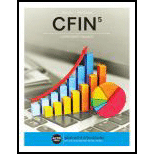
Concept explainers
NPV of the project is calculated by discounting the cash flows as below:
Here,
Expected net cash flow in Period t is “
Required
In order to discount the cash flows to is present terms, it is essential to use the appropriate discount rate. The discount rate considers the risk of the project and considers the market risk as one of its components. This discount rate or required rate f return on the project can be calculated using
Required return of a project is calculated using CAPM as below:
Here,
Required return of the project is “
Risk free rate is “
Market rate of return is “
Market risk or beta of the project is “
The project has a beta co-efficient of 1.3 with prevailing risk-free rate of 3% and market risk premium of 6%. The company needs to evaluate a project which has an initial investment of $405,000 and after-tax net cash flow of $165,000 for the next three years.
Want to see the full answer?
Check out a sample textbook solution
Chapter 10 Solutions
CFIN (with Online, 1 term (6 months) Printed Access Card) (New, Engaging Titles from 4LTR Press)
- Beta Company Ltd issued 10% perpetual debt of Rs. 1,00,000. The company's tax rate is 50%. Determine the cost of capital (before tax as well as after tax) assuming the debt is issued at 10 percent premium. helparrow_forwardFinance subject qn solve.arrow_forwardPlease help with questionsarrow_forward
 Intermediate Financial Management (MindTap Course...FinanceISBN:9781337395083Author:Eugene F. Brigham, Phillip R. DavesPublisher:Cengage Learning
Intermediate Financial Management (MindTap Course...FinanceISBN:9781337395083Author:Eugene F. Brigham, Phillip R. DavesPublisher:Cengage Learning EBK CONTEMPORARY FINANCIAL MANAGEMENTFinanceISBN:9781337514835Author:MOYERPublisher:CENGAGE LEARNING - CONSIGNMENT
EBK CONTEMPORARY FINANCIAL MANAGEMENTFinanceISBN:9781337514835Author:MOYERPublisher:CENGAGE LEARNING - CONSIGNMENT

